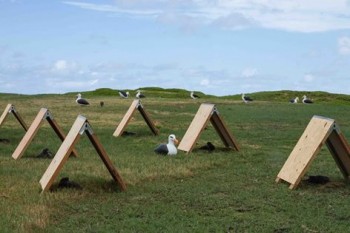Eric Vanderwerf and colleagues of Pacific Rim Conservation have published a case study that describes their work translocating eggs and chicks of Laysan Phoebastria immutabilis and Black-footed P. nigripes Albatrosses in an endeavour to create a new colony on the Hawaiian island of Oahu that will be safe from projected sea-level rise.
In the next few years it is expected that hand-reared albatrosses that fledged successfully will return to commence breeding within the fenced translocation site in the James Campbell National Wildlife Refuge. Already one Laysan Albatross has returned to the refuge as a three-year old (click here).

Translocated Laysan Albatrosses shelter from the sun, photograph by Lindsay Young
Reference:
VanderWerf, E.A., Young, L.C., Kohley, C.R. & Dalton, M. 2018. Translocations of Laysan and black-footed albatrosses in Hawaii, USA, to create new protected breeding colonies safe from climate change. In: Soorae, P.S. (Ed.). Global Reintroduction Perspectives: 2018. Case Studies from around the Globe. Gland, Switzerland & Environment Agency, Abu Dhabi, UAE: IUCN/SSC Reintroduction Specialist Group. pp. 100-105.
John Cooper, ACAP Information Officer, 12 June 2018

 English
English  Français
Français  Español
Español